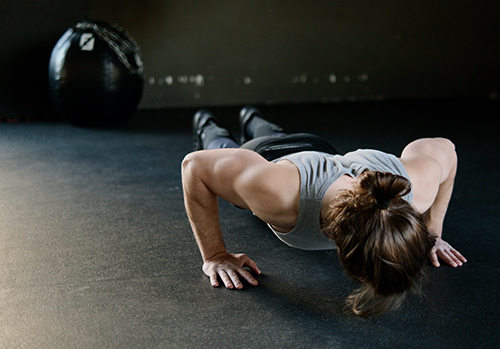Regularly exercising is a vital part of staying healthy. You can work out at home or the gym, but you should consider the proper exercise techniques to get the most benefits from your activity and avoid injury. Let’s examine some of the most common mistakes people make with popular exercise activities and how to correct those errors.
What is the proper exercise technique for push-ups?
Push-ups are an efficient way to build up pectoral muscles and chest strength. Some people do not always perform the exercise correctly, but proper technique is essential. Avoid bending the back, taking the elbows too far out, moving only halfway down, bending hips up and down instead of moving the whole body, and bending the head to touch the ground before completing the push-up.
Winderl and Sgobba explain completing the traditional push-up:
- Start in a high plank with your palms flat, hands shoulder-width apart, shoulders stacked directly above your wrists, legs extended behind you, and your core and glutes engaged.
- Bend your elbows and lower your chest to the floor.
- Push through the palms of your hands to straighten your arms to complete one repetition.
What is the proper exercise technique for squats?
Squat exercises are superb for developing your leg muscles and strengthening core muscles. Complete a full repetition by lowering yourself as if you were to sit in a chair. Do not cave in your knees. Keep your knees in line with your toes or slightly pushed out. Place your hands out in front of you. As you squat, your elbows should not reach your knees. If they do, you are rounding your back and not squatting correctly. Ensure your back is straight as you squat by looking forward, opening your chest, and relaxing your shoulders. Keep your hands out in front of you. Do not rise on your toes. Instead, keep your heels on the floor. Lift yourself by pushing off from your heels for proper exercise technique.
What is the proper exercise technique for lunges?
Lunges strengthen mobility and work out hamstrings, quadriceps, and glutes. As you complete a lunge repetition, do not move your front knee too far forward. Doing so can cause a knee injury. Instead, lunge forward with your front knee traveling no further than your toes. Additionally, do not lean your chest forward. Keep your back in a straight line and look straight ahead throughout the repetition for proper exercise technique. Remember to keep your core engaged and your chest upward. Push through the heel of the foot to generate the movement and maintain your balance.
How else can I exercise safely?
Medical professionals suggest warming up with light cardio exercise before starting your workout. “Warming up increases your heart and blood flow rates and loosens up other muscles, tendons, ligaments, and joints.” Carefully and slowly stretch before exercising. Breathe before and after each stretch. Remember to perform repetitions slowly and with control for safety and to get the most out of your workout. “Breathe regularly to help lower your blood pressure and increase blood supply to the brain.” Drink about one pint of water 15 minutes before and after your exercise routine. During your workout, have a drink of water every 20 minutes. Cool down afterward with a light cardio exercise with slow motions and less intensity.
Remember to take days off to recover adequately. Consult a physical trainer to see if you are performing exercises correctly.
If you want to learn more about healthy exercise habits, please read about how walking can benefit your health.
Agents
We hope that this information on proper exercise techniques is useful to you.
Empower Brokerage is dedicated to helping you make informed decisions about your health and finances. Whether it’s through webinar training, one-on-one calls, seminars, or marketing plans, we want you to be successful!
Give us a call at 888-539-1633 or leave a comment below if you have any questions.
Quick links:
Joey Hinojosa graduated with a bachelor’s degree in broadcast journalism and a master’s degree in mass communications. He began working at Empower Brokerage in early 2022 and enjoys being creative in his writing, photography, videography, and other projects.





